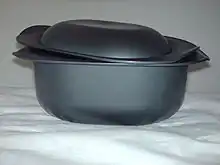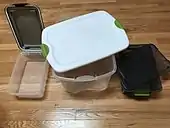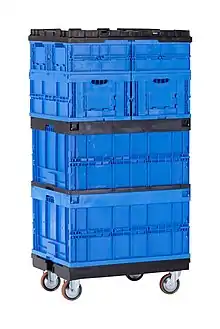Plastic container
Plastic containers are containers made exclusively or partially of plastic. Plastic containers are ubiquitous either as single-use or reuseable/durable plastic cups, plastic bottles, plastic bags, foam food containers, Tupperware, plastic tubes, clamshells, cosmetic containers, up to intermediate bulk containers and various types of containers made of corrugated plastic. The entire packaging industry heavily depends on plastic containers or containers with some plastic content (e.g. plastic coating or when made of composite material), besides paperboard and other materials. Food storage nowadays relies mainly on plastic food storage containers.




A basic but important distinction is between single-use / disposable and multi-use / durable containers. The former makes up a notable portion of the global plastic waste (e.g. toothpaste tubs, food delivery foam containers, most plastic bottles, etc.).
Because of the multitude of container applications, the types of plastic vary widely. Because of the material variety (combinations are no exception), the waste will make up a significant portion of plainly visible plastic pollution although some containers like bottles are recyclable.
Plastic has replaced traditional materials like wood, paperboard, and metal for the manufacture of containers because of its price, moldability/formability, durability and light weight.[1] Alternatives such as cotton bags, cardboard boxes and aluminum cans often have larger ecological footprints because these use up more energy and water to manufacture and transport than their plastic equivalents.[2] In addition, very few countries have facilities for recycling materials that are deemed to be less environmentally harmful than plastic. In most cases, this allegedly safe packaging gets in the natural landscape in the form of waste.[3]
Recently, some water bottles made of polystyrene and polycarbonate have been examined for contaminations by advanced laser spectroscopy method.[4] Aluminum and cyanide were found as trace elements in the examined samples but they are considered to be toxic elements according to the United States food and drug administration (FDA). In 1997, the FDA set up Packaging and Contact Substances–a regulatory system to determine the safety of packaging products. Those who manufacture a' food touch material,' like chemical additives, coatings, paper or polymers, must first get their all right from the FDA before putting it on the market.[5]
Trade groups
In the U.S., the industry is represented by the Society of the Plastics Industry, Closure & Container Manufacturers Association, Flexible Packaging Association, and others.
Global market
Asia Pacific dominated the global plastic packaging market in 2016. In second place comes North America. The pharmaceutical and food and beverage industries contributed the most to the use of plastic packaging products. During 2016, Asia Pacific accounted for more than 30 percent of the shares of the total volume consumption in this market.[6] The Ocean Conservancy reported that China, Indonesia, Philippines, Thailand, and Vietnam dump more plastic in the sea than all other countries combined.[7]
In the late 2010s, 150 companies signed up to be part of The Ellen MacArthur Foundation's commitment to reduce plastic pollution. In a 2019 report, The Coca-Cola Company divulged the company created 3 million tons of plastic packaging in 2017 with Nestlé creating 1.7 million tons, Unilever creating 610,000 tons and Colgate-Palmolive nearly 300,000 tons.[8]
See also
References
- "The inflexibility of plastic". The Economist. 25 July 2019. Retrieved 31 July 2019.
Given the environmental footprint of substitutes like cotton bags, aluminium cans or paper boxes—which often require more energy and water to make and transport than plastic equivalents—new regulations could in fact end up doing harm to the planet.
- "Plastic packaging ban 'could harm environment'". BBC News. 9 January 2020.
- Farooq, W. A.; Al-Johani, Awatef S.; Alsalhi, M. S.; Tawfik, Walid; Qindeel, Rabia (2020-02-05). "Analysis of polystyrene and polycarbonate used in manufacturing of water and food containers using laser induced breakdown spectroscopy". Journal of Molecular Structure. 1201: 127152. doi:10.1016/j.molstruc.2019.127152. ISSN 0022-2860.
- "SCOGS (Select Committee on GRAS Substances)". www.accessdata.fda.gov. Retrieved 2020-01-20.
- "Growth of the plastic packaging market in regard to regions". Openpr.com. Retrieved 2018-08-30.
- Hannah Leung (21 April 2018). "Five Asian Countries Dump More Plastic Into Oceans Than Anyone Else Combined: How You Can Help". Forbes. Retrieved 23 June 2019.
China, Indonesia, Philippines, Thailand, and Vietnam are dumping more plastic into oceans than the rest of the world combined, according to a 2017 report by Ocean Conservancy
- Staff Writer (2019-03-14). "Coca-Cola reveals how much plastic it uses". BBC News. Retrieved 2019-03-15.